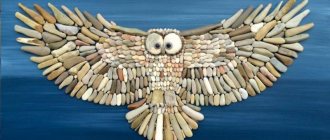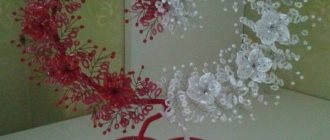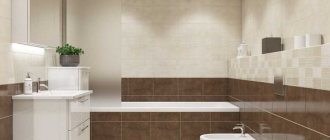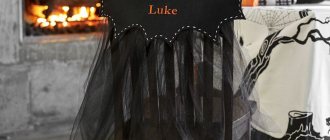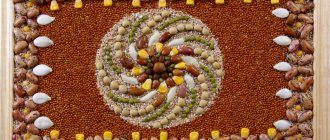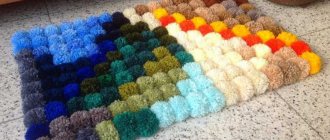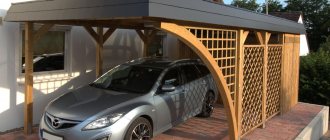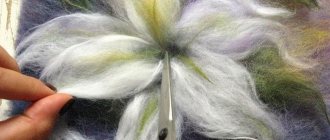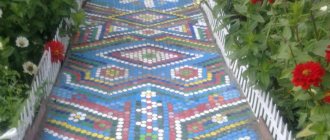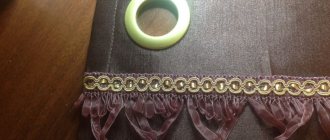Neat and beautiful flower beds are a wonderful decoration of the garden. They can be located in the garden itself, or along the path running from the gate to the house, and also serve as a kind of fence, marking the boundaries of the territory. Depending on the height of the flower beds, their shape, purpose, and your aesthetic preferences, you can use different materials and their combinations for fencing them.
For example, stone, concrete, brick, wood, tile, metal, glass, and ceramics. Recycled items such as dishes, wheels, tires, etc. are also suitable.
Our garden landscaping ideas here will help you gain inspiration and take your garden landscaping to the next level!
Concrete fencing
Concrete and stone fences are often very similar to each other, because an imitation of stone can be made from concrete. Thanks to this, you can make solid fencing walls from concrete, or lay them out from pieces, or make horizontal edgings of flower beds.
Read also the article “Hedges: what to plant?”
Here is one example of the arrangement of such flat stones made of “broken concrete” around the corner of a house.
It draws attention to the plants planted against the background of the wall of the house.
The following example shows how to make a low relief wall from concrete.
This design is very reliable and durable. It can also be painted or decorated in some other way, for example, by laying out a small mosaic.
Photo gallery of fences for flower beds
In the photo gallery you will find visual examples of unusual types of hedges for flower beds. Moreover, many of the materials used are available to almost every owner. The main thing is imagination and the desire to create.
With a beautiful fence, the flower arrangement will look complete. A fence for a flower bed will successfully divide the area into zones and highlight the colorful colors of flowers against the background of a green lawn or path surface.
Brick fences
Bricks and pavers can be carefully laid around flower beds to create simple, neat patterns.
And here you can see ideas on how and what to decorate a fence at the dacha
For example, place one row horizontally and the other vertically.
And two more similar options:
Or this pattern, made of ordinary bricks. Each piece of the pattern consists of 4 bricks and a decoration in the middle.
As an additional decoration element, you can add lighting along the inside of the brick fence.
Thus, the flowerbed will look wonderful not only during the day, but also at night.
Bricks can also be laid at an angle, as in the next photo. The result is a jagged fence that creates a rustic look.
Flowerbeds can be located on both sides of the path in the garden, and in this case, it will serve as their fence.
To make it more unusual, you can experiment with the shape and make it wavy rather than straight.
And another option with brick:
Stone shaft
For builders and lovers of stone and concrete, a more durable option is to make a stone fence. We collect pebbles or boulders and place them evenly around the bed, fixing the structure with cement. The height, smoothness of the surface, width can be adjusted according to your wishes.
If there is an extra grid on the site, then we proceed differently:
- We measure the length of the ridge.
- We divide the resulting length into zones of 50 cm.
- Using the same step, we dig in metal pins or straight wooden posts.
- We fix a tensioned chain link between them.
- We fill the space in the grid with stones of various sizes.
Metal fencing
Flowerbeds can be planted either at the level of the entire landscape or slightly raising them above it. When making an elevation, it is important that it is strong and secure, and holds the flowerbed in place. A material such as metal will cope with this task wonderfully.
Look, for example, at the following photo, in which a raised flowerbed is protected by a “rusty” metal winding. Simple and beautiful!
And here is another similar option, but here the fence goes in a zigzag, not in waves:
Corrugated steel panels can also be used. When combined with wood they create an interesting and modern design.
Types of fencing for flower beds
Fences for flower beds have different functional purposes, which means that fences are selected accordingly depending on the purpose of their use:
- Lawn and flower garden section. For this, a small fence, the height of which is no more than 7 centimeters, is sufficient.
- Border for a path or path. In this case, the fence should be more powerful, and its height should be 10-15 cm.
- Raised flower beds. It is best to cover them with stone or brick, since you need to keep the soil within a certain space. A strong and stable fence will allow the flower bed to remain unchanged for a long time.
- Root blocking. If you do not allow the flowerbed to grow beyond its limits, then you need to take care of high-quality fencing. The fence should go deep into the ground; it is best to use plastic or masonry; wood is not suitable.
- Protection from animals and children. If you protect plants from animals running around the territory or inquisitive children, then the fence must be installed high (about half a meter). To maintain visual appeal and aesthetic appearance, you need to use picket fences. The material can be metal, plastic or wood.
Stone fences
Stone is a very popular material for edging flower beds as it gives them a natural and natural look. Stones have many shapes, sizes, colors, and also differ in appearance and texture. This allows you to use whole stones for construction, or trimmed ones, as well as their combination for the desired result.
Gabion fencing
Gabion is great for fencing flower beds. It looks natural, yet structured, and blends well with the environment. It is also strong, reliable and durable.
The metal cage can be divided into sections (for example, by wooden partitions, as in the first example), or be integral. The size of the stones for filling the gabion and their shape can be very diverse, the main thing is that they do not fall out through the checkered fence.
Stacked Flat Edged Stones
One simple way to fence a flower bed is to use flat edged stones, laid out on top of each other around the flower bed in several layers.
Small pebbles
A small stone border can separate both a flowerbed and a lawn and a house and a lawn. To do this, you need to make a small depression along the border and fill it with small pebbles.
Packing crushed stone between bricks
This lawn fencing idea provides contrast with the brick and wide strip of crushed stones.
Here is another example of this use of small pebbles:
Here, pebbles of different colors were used to enhance the contrast of the border.
Stones combined with bricks
This fencing of smooth stones and bricks gives a very natural, not too “flawless” look. As you can see, there are no complicated instructions for installing rock landscaping, other than the fact that each stone will need to be lifted and put into place, and this requires a certain amount of physical strength.
Using stones of different sizes provides great contrast. Small stones create a nice transition border, while large stones form the main border and keep the flower bed raised slightly above the level of the lawn.
It is also possible to combine stones with sand, in which case it is as if you are creating a small piece of the beach in your garden.
And a few more options with stone:
And even marble:
Classification of fencing and selection of material
Photos of regular type flower bed fencing
In general, flower beds are divided into regular and free. Regular gardens of small size include ridges and flower beds. As a rule, structures of this kind have a regular geometric shape and are distinguished by more or less clear contours.
Traditionally, they use fences made of metal, stone, brick or plastic. Their appearance, as a rule, is emphatically artificial, that is, it becomes immediately clear that they are the result of the designer’s work, and did not arise on their own.
Free flower beds are various groups (rock gardens, rockeries) or mixborders. Such flower beds look much better against the background of more or less natural fences: wood, boards, various wicker structures, logs, chocks, etc.
Rock garden - a free-type flowerbed with a fence made of wild stone
It is also popular to use natural materials for this purpose - natural stone and thick wooden structures with minimal instrumental intervention. Such “natural” style flower beds are specially designed in such a way as to create the impression that they have not been touched by a human hand at all.
Next, examples of the implementation of fences made of various materials will be considered.
No. 1 Wooden fencing
The simplest wooden fence for a flower bed is a classic picket fence.
Wood is the most natural and closest to nature material. Therefore, wooden structures for flower beds are used to create a “rural” design style. In this case, wooden elements are often combined with stones, various garden animal figures, benches, gazebos, swings, etc.
The advantages of wood include:
- ease of processing
- ease of choosing a processing tool
- environmental friendliness and easy disposal
- the tree does not heat up under the rays of the sun, which eliminates the possibility of plant burns
- it is quite durable and can serve as a support for creeping or climbing representatives of the flora
Wooden structures have only one drawback - they are short-lived. In addition, this kind of fence attracts various pests and diseases (bark beetles, fungal diseases, etc.)
Wooden flowerbed fencing made of semicircular logs
It is recommended to treat it with an antiseptic before using wood in fencing design. This extends its service life by 1.5-2 times.
The following materials are used for the manufacture of wooden fences:
- board
- fence
- timber
- croaker
- small logs
The use of each of the materials considered has its own characteristics. So, to create regular flower beds, they use parts of the same size - a board or timber, and install them at the same level. For free structures, on the contrary, they use elements of different shapes, eliminating symmetry or repetition of individual nodes.
Wooden flower bed fencing
Making a fence is relatively simple. Let's look at step-by-step instructions for making a wooden fence from the materials at hand.
- Select elements (beams, logs, slabs, posts, palisades, etc.) of the same thickness
- All elements are aligned in length. It should be taken into account that 15-20 cm will be below ground level
- Wooden structures are treated with an antiseptic. The bark is first removed from the logs or slabs
- Along the perimeter of the flowerbed, soil is removed to a depth of 20 cm
- The finished fencing elements are installed in a row, leveling the height with a stretched cord, rope or level
- The groove with the fencing elements is covered with earth and carefully compacted.
In principle, such an algorithm is suitable for any material consisting of elements of more or less identical sizes.
No. 2 Wicker fences
Fencing in the form of a fence
A particular type of wooden fence in which the posts are not installed in a continuous row, but at significant intervals. The space between them is filled with flexible wicker structures made from thinner branches.
The most common materials used for braiding are willow or hazel, as they are very flexible.
Making such a fence is also easy:
- Along the perimeter of the flower bed, pegs are installed every 30-40 cm
- The weaving rods are cut to the same length (at a minimum it should be 10-15 cm longer than twice the distance between the pegs)
- The pegs are entwined, allowing flexible vines to spread from the inside or outside of the flower bed.
- Having laid 3-4 rows, they are compacted with a mallet
- It is recommended to nail the ends of the rods to the pegs with small nails
DIY wicker fences for flower beds
This design is quite strong and reliable. It is also recommended to treat all its elements with an antiseptic.
In winter, such structures are an excellent shield that holds snow. This will help keep the perennials in the flowerbed from freezing.
No. 3 Stone fences
Natural stone fencing
There are two fundamental approaches to the construction of stone fences : with or without the use of cementitious mortar. Stone fences, although expensive to manufacture, are stronger and more durable.
The main problem in the manufacture of stone fences is the correct selection of structural elements in size. Only products made from artificial stone have more or less the same dimensions, and even then, not all of them.
Selecting fencing elements can take quite a long time. Therefore, in most cases, it is not dry installation that is used, but the fastening of stones with mortar, since in this case their dimensions do not play a role.
A special case of using stones when creating fences is the use of special curb stones, products made of tuff, granite, limestone, etc. As a rule, such materials are rectangular in shape and quite large in size.
The process of installing them is simple, and, in fact, consists of laying them in even rows in a pre-dug groove. A shock-absorbing layer of fine crushed stone or gravel is poured onto the bottom of the groove.
Gabions - fences made of mesh filled with stones
Using sand as a “substrate” is acceptable, but not recommended. This material is well wetted with water and is washed out over time.
But borders made of small and medium-sized stones (pebbles, cobblestones, etc.) are always held together with mortar, otherwise they move apart over time in different directions and the fence simply crumbles.
An alternative to the methods described above for installing stone fences is the use of gabions - special mesh containers filled with pebbles or crushed stone.
No. 4 Brick fencing
Brick flower bed fencing
A special case of a stone fence. Its popularity is due to several features:
- all bricks are almost the same in size; this greatly simplifies installation
- clay has low thermal conductivity, so this fence does not overheat
- brick is moderately hygroscopic, so it can remain in damp conditions for a long time without destruction or loss of shape; for additional protection from moisture, it is recommended to place a layer of crushed stone in the trench under the bottom of the brick
Like all stone materials, the main disadvantage of brick is the high labor intensity of working with it.
Flowerbed fenced with bricks laid at an angle
To make a fence from this material, you need to do the following:
- Dig a groove up to 20 cm deep along the perimeter of the flower bed.
- At characteristic points of the perimeter (at corners, in the middle of long sections, etc.) pegs are installed on which the cord is pulled at a level corresponding to the height of the fence
- A 7-10 cm cushion of gravel or small crushed stone is placed at the bottom of the groove
- The groove is filled to the top with a solution (3 parts sand, 1 part cement), leaving no more than 3 cm to the soil level
- The bricks are laid so that their top part touches the cord
Brickwork can be done either with bricks lying flat or standing on the end. In some cases, masonry is used at an angle.
Paving slab fencing
It is possible to use bricks without cement mortar, but in this case the hole can be made less deep, and the bricks themselves can be laid on top of each other, as with conventional wall masonry.
As an alternative to brick, you can use paving slabs. What will look best on the site depends on the population of the flower beds. So lush pink or purple peonies will contrast well with the gray color of the tiles.
While the color scheme of white plants (roses, decorative viburnum, some types of tulips, etc.) will look great against a background of red or red-yellow brick.
No. 5 Concrete fencing
Flowerbed with concrete fencing
Theoretically, this method can also be classified as stone fencing. In this case, at the site of the future fence, formwork of the required height with sufficient recess into the ground is installed.
As a rule, not the entire volume of formwork is poured, since this will require mixing a relatively large amount of concrete. First, rubble material is poured inside, which consists of stones that are not suitable for use as a fence in their natural form due to their size, shape, or poor exterior.
After the concrete is poured and hardens, it is coated with paint (the appearance of concrete as a flowerbed fencing is not very aesthetically pleasing), and a water repellent is applied on top.
Broken brick can be a good material for rubble.
No. 6 Metal fences
Forged flower bed fencing
Most often, forged products are used as hedges for flower beds. These can be either ready-made grilles consisting of identical fragments, or decorative structures of various types and sizes. Typically, this fencing method is used in the case of tall plants in a flower bed or too dense plantings with a large number of branches and leaves.
On the other hand, forged metal is universal for use with any colors - its sizes and shapes can be ordered (or made independently) in any form and for any occasion.
You should know that this type of design is also not without its drawbacks. The main thing is their high cost. In addition, forged metal requires corrosion protection, which must be renewed from time to time.
You also need to understand that solid metal structures should not be used. Firstly, they have a large mass. Secondly, rust protection on such structures should be applied over a much larger area than for forged products. This not only increases the labor intensity of the work, but also further increases the cost of materials.
No. 7 Plastic fencing
Plastic fencing in the form of a regular border
Currently, this fencing material is experiencing a real boom. Plastic is a light, strong and durable material. Moreover, it does not rot and is not exposed to solar radiation. This material will perfectly replace all those listed earlier in terms of functionality.
Fences are made from plastic that imitate almost any material. A variety of types of decorative plastic allows you to realize almost any individual designer’s fantasies at relatively low material costs. Working with plastic is much easier than with any other material.
Elements of plastic fencing
The current level of development of the chemical industry makes it possible to create plastic with colors that are practically no different from products made of wood or metal.
There are a variety of plastic elements for fencing:
- logs, bars, slabs identical to natural in color and shape
- fence
- curb tapes and boards
- solid fences
- and much more
Plastic fence made in the form of a picket fence
Plastic products are very convenient and practical; in addition, their price is the lowest among all available fencing materials.
No. 8 Slate fencing
Slate as a border for a flower bed
Slate is a fairly durable structure that does not lose its shape, unlike some plastic products (for example, curb tape). In garden design, both flat and wave slates are used.
Since slate does not bend, it is used in relatively short pieces. Usually, the material is pre-cut along the wave into 4-5 parts. The recommended number of plates obtained from one unit of slate is 4 and above.
Just as in previous cases, a groove is dug under the slate (it should be already discussed previously, no more than 10 cm) up to 20 cm deep. Pre-cut pieces of slate are placed in the groove, after which it is covered with earth and compacted.
Some gardeners do not recommend using slate as a fencing material because it contains asbestos, which can adversely affect the delicate roots of most young plants.
Wooden fences
Wood, like brick and stone, comes in many forms. The most common type of fencing is the raised garden bed, but as you'll see, there are many more types!
Horizontal wooden beams
The beams are placed at angles to the fence and only one plant is planted in each “growing zone”. Also used here is a combination with decoration with small pebbles.
Vertical wooden beams
Such beams, cut to different lengths, make the fence a little chaotic and give it uniqueness.
Here's another example where the beams are already aligned to the same length:
You can also add original decorations, such as “stone legs”, or anything else interesting that you want!
Small fence
Fencing a flower bed in the form of a miniature fence is very simple to do, but it looks interesting and funny. The boards can be simply varnished, painted plain, or a combination of different colors. The fence can be smooth, or consist of boards of different lengths.
Or here’s another example of a small fence made from old pallets:
Chopped trees
Wood can be used as a fence even in its most natural form, that is, using tree trunks or their thick branches.
And a few more options for using wood:
Using scrap materials
Bamboo fence
Flowerbed fencing can be made from literally anything. Any materials available at hand can be used as raw materials for the production of fencing.
Their use does not require any special skills. Below we will consider examples of the use of various structures, building materials and simply unnecessary things for the manufacture of fences for flower beds.
No. 9 Bamboo fencing
The easiest way to purchase bamboo fencing is in the form of a ready-made roll.
Bamboo fences Small bamboo fences will be a great addition to Asian-style landscaping. This material is highly durable and lightweight, and its installation is relatively simple.
Currently, you can purchase different types of bamboo, differing in diameter and wall thickness. As a rule, bamboo does not need antiseptic treatment.
No. 10 Metal pipes
If the diameter of the pipes is sufficient, you can fill them with some decorative material or even plant plants with a small root system
Metal pipes The idea of such a fence is completely the same as bamboo, but a more durable material is used - steel. Quite often, during the construction of various structures (from residential buildings to utility rooms and site fencing), a large number of pipe scraps remain. It’s a shame to throw them away, and selling them at the price of scrap metal is not profitable.
Such pipes can be used to construct a flower garden fence or as a border for garden paths. They should be cut into pieces of equal length and driven into the ground at the appropriate level using a heavy sledgehammer. Such a landscape solution will look very stylish, especially as a fence for a lawn or front garden in a country house.
It is best to use pipes that are corrosion resistant (for example, made from Corten steel). If you don’t have any at hand, it is recommended to paint them in any practical color, having carried out preliminary preparation in the form of stripping and priming.
No. 11 Glass bottles
Flowerbed border made of green glass bottles
Glass bottles The convenience of round structures when creating fences is obvious - all elements are more or less the same and can be located arbitrarily next to each other. Since the bottles are also round in shape, they can also be adapted for the purpose of fencing flower beds. The green shades of most types of glass will harmonize perfectly with the surrounding landscape.
Glass has good resistance to external influences, in addition, since the bottles have a pointed part in the form of a neck, they can be easily fixed in the ground. The sizes of the bottles allow (albeit within small limits) to adjust the height of the fence.
The only drawback that should be remembered when using such fences is that glass is quite fragile and tends to break into many small fragments upon impact. Therefore, economic work near such a fence should be carried out carefully.
No. 12 Polyethylene containers
Flowerbed fencing made of polyethylene bottles
Polyethylene containers Instead of glass bottles, you can use polyethylene ones. They are strong enough to hold back the soil spreading from moisture, and, at the same time, they do not have the disadvantage of glass - increased fragility.
However, this design also has disadvantages - under the influence of solar radiation and precipitation, polyethylene decomposes within several years.
To give greater strength to a fence made from polyethylene containers, it is recommended to fill it with some kind of bulk material - sand, soil or small crushed stone.
No. 13 Use of industrial roofing materials
An example of using corrugated board fencing
Using industrial roofing materials You can also use remnants of unused corrugated sheets, bitumen shingles, plexiglass, polycarbonate and other similar materials as a fence. They are quite strong and durable, in addition, they have an aesthetic appearance.
Currently, even stationary fences for flower beds are produced, made of corrugated sheets, polymer tiles or tin. They are even multi-tiered.
Three-tier flowerbed "Roof"
No. 14 Large shells
Quahog shells as a border for short flowers
Large shells Large bivalve shells (such as Arctica islandica or Quahog species) can also be used to create a small fence around a flower bed.
In this case, the design technique of playing contrasts is used: mollusk shells have a gray, white or dark brown tint, which makes them clearly visible against the background of green vegetation and bright colors.
No. 15 Plates
Fencing for a flower bed made of small earthenware plates
Plates You should not throw away an old set if the paint has peeled off and there are small dents around the perimeter. Old plates can be an original option for fencing a flower bed in a summer cottage. Plates with a diameter of 20-30 cm are ideal for this purpose.
The configuration of your fence in this case can be very diverse. For example, you can place plates in several rows. If you want to give your flowerbed additional attractiveness, you can use dishes of different colors and sizes.
Porcelain or earthenware, as well as glass bottles, are quite fragile, so care should be taken when working near this type of fence.
#16 Vinyl records and CDs
Fencing made of gramophone records.
Vinyl records and CDs An interesting idea for fencing a flower bed would be to use old vinyl records. These storage media lost their relevance several decades ago, so if you have records lying idle in the house, you can adapt them for use as an unusual decoration for flower beds at your summer cottage.
Plates with a diameter of 25 or 30 centimeters are best suited for this purpose. Since they are very thin, there is no need to bury them in the ground, just press them into the top layer of soil with a little force.
The best option for using this material would be not to simply install disks next to each other, but to create a structure from disks connected in a chain. The optimal number of disks in one chain is 6 pieces. The finished chains are attached to pegs, which are driven in at a distance of 75 cm from each other (5 radii of 15 cm each).
Although they are smaller in diameter (only 12 cm), they contain a metal layer that pleasantly shimmers in the Sun with all the colors of the rainbow and creates a lot of glare, which gives the flower bed a bright and very impressive look. This design can decorate any landscape.
One of the best ideas for using CDs is to create separate panels measuring 30 by 100 cm, on which they need to be laid out in the shape of fish scales, using glue or liquid nails for joining. The structures obtained in this way can be used to fence the perimeter of flower beds and beds. One section of the specified size will require approximately 30-40 disks.
Fencing panel made from CDs
As an alternative to black records, you can use CDs or DVDs.
No. 17 Car tires
The easiest way to use them is to simply dig them in around the perimeter of the flower bed.
Car tires One of the most interesting options for decorating a summer house is ordinary car tires.
When using a car in a garage, once every 3-4 years a set of four tires that have already served their useful life appears, which will help in creating interesting design solutions for flower beds.
Flowerbed made from several tires
Also, tires can be used as independent flower beds, which can be arranged in cascades. If you have tires of different diameters, you can create multi-tiered compositions.
Multi-tiered flower bed made from car tires
When using tires in such structures, it is recommended to give them a stable position - place them in a horizontal plane at several points of support.
Flowerpot made from a car wheel
In addition, they can be used to make various sculptures and other individual elements of landscape design.
Thematic video: ❀ DIY fencing for flower beds: options and ideas
❀ DIY fencing for flower beds: options and ideas
Fencing for flower beds | TOP 17 Ideas for creating and arranging fences with your own hands (80+ Photos & Videos) + Reviews
Wicker fences
These fences are the true embodiment of rustic style, and are made mainly from wicker.
But it is also possible to weave a fence using old hoses.
Plastic
As for plastic fencing for flower beds, empty bottles and other containers come in handy. There are many ways to use them:
- Cut in half and plant with flowers, repeating the option with a flower row.
- Dig into the ground up or down, repeating a standard wooden fence.
- Stick it into the ground (we form a high ridge, and insert bottles in rows on the sides).
It is also possible to build a high flower bed, for which the bottles installed on the neck are additionally fastened with wire or rope in two rows.
Garden gazebos - construction- Clinker brick
- Barrel sauna and its features
The main thing is not to forget to experiment with color. Also, no one forbids decorating the finished bed with plastic flowers from cut containers or laying out inscriptions from the lids.
Other fencing materials
We have already considered the main materials, so finally we offer ideas for fencing made from unnecessary items found at home.
Glass bottles
Dishes, pots
Wheels, tires
Old furniture
Bowling balls
Shells
Wooden and metal buckets, baths, etc.
Old pipes
Raised flower bed with hay fencing
Stone fence
In this case, stone means brick, natural and artificial stone, as well as paving slabs. Laying can be done either dry or using solutions. If desired, the stone can be combined with each other or with wooden elements. The main advantages are the durability and high level of reliability of the fence; the only drawback is the high price.
Paving slabs have different shapes, configurations and colors, which means they can be used for a wide variety of flower beds, ideally used for laying miniature flower beds.
Plastic fencing
Plastic looks very interesting and, first of all, captivates with its performance qualities: it is resistant to temperature and moisture, lasts a very long time, while retaining its original shape. Such a fence is very easy to install and dismantle; replacing it will not be difficult. Also a plus will be the wealth of choice in color, shape and size of the fence. By choosing a fence according to the style and landscape design, you can create an interesting composition; in addition, you can use plastic that imitates other materials (stone, wood).
A number of basic options for plastic fencing:
- Sectional fence.
- Plastic border.
Materials and heights of curbs - advantages and disadvantages
Any material can be used to zone the territory on the site. When choosing, you should take into account its features and characteristics. Borders for garden beds must be strong and reliable, able to withstand the pressure of heavy, wet soil. The specifics of the soil and the effect of chemicals on the part of the fence buried in the ground should be taken into account. You can install any garden border with your own hands; some types can be made independently from scrap materials. The size of the fence depends on the area, configuration of the flower bed or bed.
Plastic
The raw material for making borders is a non-toxic polymer. The material does not release toxic substances into the soil and does not deform at low or high temperatures. The following types of plastic fencing are suitable for any climatic conditions:
- Border tape. The flexible polymer can be 0.1-0.5 meters wide. Suitable for both forming beds and fencing shrubs. Mobile, lightweight product is easy to install. It is enough to dig a shallow trench around the lawn, stretch the tape, and secure it with stakes. Disadvantages: fragility, high probability of deformation due to mechanical damage.
- Net. Used for zoning areas, fencing flower beds and low beds. Often used as an additional barrier. Cons – does not retain moisture in the watering area, shaky, unstable structure.
- Plastic panels. Excellent moisture retention and soil pressure retention. The width of each polycarbonate piece does not exceed 15 cm; if desired, you can connect them and make a high fence. The simple design is assembled using corner fasteners and grooves.
- Garden designer. The universal set for garden beds includes several plastic parts that are connected thanks to special grooves. Can be used for flower beds, beds of any irregular shape. Plastic board. Similar to panels, but different in composition and appearance. Boards are made from wood waste and polymers. The product has the texture of natural material. The finished box is fixed in the ground thanks to hinges and stakes.
Metal
Flat curbs are made of steel, corrugated board, galvanized, coated with polymers, which significantly increases the resistance of the material to the negative effects of moisture. Decorative structures can be purchased at the store or you can make your own metal box from roofing iron and corners.
Some of the most durable types of borders expressively define the boundaries of paths and harmonize with all surfaces of garden paths. Metal fences can take the form of ribbons, rods, blocks made of corrugated sheets, and can follow any winding shape of a flower bed.
Decorative fencing has several significant drawbacks - it quickly heats up in the sun, which is detrimental to plants in contact with it. You can reduce the temperature by lining the inside of the fence with cardboard. The high cost of the material also reduces the demand for this type of border.
Brick
The brick border looks reliable and solid. Facing bricks can withstand temperature changes, street conditions, and constant contact with the soil. Simple material for marking boundaries allows you to adjust the height of the structure and fits perfectly into any design of the local area.
Any owner of a summer cottage can make a border out of brick or foam block on his own. The work does not require special construction skills. Fast and easy execution is supported by an affordable price. Thanks to the universal shape of the red bars, you can design borders of any shape - in the form of a ladder, in rows on an edge. Negative aspects include the need to fill the foundation and lengthy phased installation.
Concrete strip fencing
Durable concrete mortar curbs have the longest service life. The permanent structure is installed on previously prepared soil. You will also need to make formwork and prepare a solution of cement, water, sand. The form for pouring can be made from wooden boards or plywood, taking into account the width of the future fence - it should be at least 15 cm.
Practical concrete curbs do not change the acidity of the soil. Such a fence can be stretched across the entire site, beds and flower beds can be decorated in the same style, and pedestrian paths can be identified. You can diversify the gray unsightly material with the help of mosaics. The top edge of the border is decorated with glass fragments, colored stones, shells, and the bottoms of glass drink containers.
The disadvantage of strip concrete fencing is its heavy weight and inability to be dismantled. Such a board cannot be installed on loose soil. From an aesthetic point of view, it is suitable for beds with massive, tall crops. Delicate strawberries and primroses will look ridiculous against the background of a concrete fence.
Natural or artificial stone
Stone fences have the most attractive appearance. Decorative, artificial stone is not inferior in strength to concrete and brick. The variety of materials allows you to create real design masterpieces, making simple, elevated structures.
Garden beds with a stone fence are a bright picturesque element. The surface of the parts can be smooth, chipped, fired, polished, aged, etc. Regardless of the design, the natural material does not lose its attractiveness and looks beautiful at any time of the year. You can combat inevitable contamination with the help of special impregnations.
Artificial stone imitates the look and texture of natural material, but is cheaper. Durable borders can be given any shape. The only difficulty is the need for minimal masonry skills, alternating uneven edges to obtain a durable fence.
Wattle
Once upon a time, an unchanging attribute of a rural yard was very popular. The wattle fence was present at every site. Modern summer residents use a semblance of tyn to create original beds and flower beds in an ethnic, eco style. Wicker structures will give the site a natural look without any financial investment.
Frame borders made of flexible branches have mainly decorative value and go well with other materials on the site. These can be hanging or ground beds. Fences can be dug into the ground or installed without fixation and moved in any direction. To stretch the vine between the posts, several methods are used: horizontal, vertical, checkerboard, oblique.
Tree
A classic option for framing beds. You can use wood of any size and finishing method. The materials used are clapboards, slabs, scraps of boards, solid barrels, and logs. With cheap, affordable material you can easily cover a flower bed in any area; it has a natural, aesthetic appearance. The box can be left without a bottom or the bottom of the frame can be covered from rodents with a metal mesh.
But not every wood is suitable for growing vegetables. Some rocks can emit resins that negatively affect the soil composition. Also, wooden borders must be periodically treated with an anti-rotting solution.
Pergones
Steel boxes with crushed filler look modern and neat. Lattice tall boxes are filled with crushed stone, pebbles, and stone treated with glass. Functional, practical, aesthetic borders fill the area with harmony and tranquility, emphasizing the closeness with nature.
The beds can be made from solid structures or individual blocks can be installed at a distance. These can be low, high, multi-tiered sides. A fence and paved paths will perfectly complement original products of the same type. The cost of pergons is influenced by the filler, type of fastening, profile, and the need for a foundation. In any case, it won't be cheap.
Plastic fencing
Plastic attracts with its excellent performance qualities: immunity to moisture and temperature changes, it is not hygroscopic and durable, and retains its shape perfectly. A plastic fence is easy to install and equally easy to dismantle, replace or rearrange. A huge plus is a large selection of sizes, shapes and colors; it’s easy to choose a plastic fence that matches the general style of the site. There are even borders that quite accurately imitate stone, wood or brick.
The main options for plastic fencing:
- sectional fences are of different colors and configurations, small in height, they already have strong cast pegs at the edges. To get a fence, you just need to drive the pegs into the ground;
- plastic fences can imitate wood, it looks nice and natural, and is doubly convenient to install: you don’t need to select wooden blocks of the same size;
- plastic border - flexible tape in a roll. With its help, you can get a flowerbed of any, the most bizarre shape, or fence off a path curving along a flower bed. The border tape can be either smooth or have a textured surface: corrugated, imitating stone or brick.
Installing plastic fencing for flower beds with your own hands will take a minimum of time.
Before installation, unroll the plastic border and place it in the sun - it will become softer and more flexible, making it easier to install.
To begin with, dig a groove around the perimeter of the planned flower bed (the depth depends on the purpose of the border). Measure the tape to the required length, and so that its ends do not diverge, fasten them with a stapler. Place the curb tape in the recess and fill its lower part, compacting the soil well.
Along the outer edge, the border can be decorated with small pebbles, crushed stone, cut bark and other bulk materials.
Metal fencing
Metal fences look very stylish, but their price is a little steep. You can use cast, forged and welded fences, which will elegantly complement the graceful appearance of the flower bed and last for a very long time. The production of such fences is carried out individually to the owner's order. The main thing is that the fence matches the landscape and fits into the overall design. They can also be used as supports for plants that climb up.
↑ Wicker fences for flower beds
If you are looking for an original idea for fencing a flower garden at your dacha, then you should opt for wicker structures. Willow vine is usually used for wickerwork, as it has both flexibility and strength. Thick stems are cut vertically into two or three parts. Instead of a vine, you can use a thick jute cord.
When installing the fence, posts are dug in at a certain distance from each other. Then they are intertwined with vines. If gaps are not left, a continuous fence will form. If the weave is not strong, you will get an original openwork weave.
With such a picturesque flower garden, your dacha will sparkle with new colors:
Types of fences
Traditionally, the main functions performed by various types of fences include:
- securing boundaries;
- protection from attacks by third parties;
- limiting direct penetration of sunlight and winds;
- ensuring privacy;
- decorative.
For the fence, you can use any available material.
For the construction of boundary fences, almost any factory and available materials are used.
Wood and its processing
Wood is an easily processed material available in our country. When properly processed, the natural structure serves as an independent element of site design. Can be painted in any color. But at the same time, wooden fencing is exposed to natural phenomena, and therefore is short-lived.
Wood wins among materials for its ease of processing, naturalness and moderate low cost.
The structure requires annual maintenance (painting, preventing the penetration of insects). Under shock loads, the material quickly becomes unusable.
The following application options are presented:
- Garden picket fence, that is, processed, parallel installed wooden planks. A picket fence can be solid or in the form of a lattice. Can be used for a vegetable garden or recreation area.
- Plank fence. It is distinguished from a picket fence by a continuous method of fastening and the use of both edged and unprocessed boards of approximately the same width.
- Palisade One of the most ancient types of fencing. It consists of wooden stakes tightly adjacent to each other, driven into the ground. The security function is increased by sharpening the upper part of the structural elements.
- Ranch fence. It is represented by fastening timber (boards) in a horizontal plane with large openings between them. It can be made from processed blanks, but this requirement is not necessary.
- Wattle fence. Economical antique fencing that does not require financial costs. It is made by driving stakes into the ground and intertwining them with young shoots of trees and shrubs. A wicker fence made of twigs or vines can become a highlight of the outdoor decor of the site.
Coating wood with protective compounds allows you to preserve the structure of this raw material for many years
To avoid premature aging of wood and its corrosion, be sure to treat it with special compounds or paint the finished structure.
Metal and its derivatives
Metal products are in second place in demand in the manufacture of various fences.
Metal fencing greatly benefits from its practicality and long service life.
They produce beautiful designs, very different in price and aesthetic perception, such as:
- Profiled sheet (corrugated sheeting) is an easily installed metal product with a service life of at least 50 years. Produced in a variety of colors. However, its appearance is simple, and the product is subject to deformation.
- Net. It does not limit the penetration of sunlight into the selected area, but also does not protect from the wind. It is made from metal in several versions: chain-link, corrugated, welded. The chain-link is distinguished from the corrugated weaving method; the second creates a more static plane, for fixing which the distance between the supports can be 5 meters, while with the first - no more than 3 m. The positive characteristics are complemented by the possibility of using a mesh fence as a base for the growth of climbing plants .
- Welded multi-element structure. A huge number of metal decorative elements can be purchased at hardware stores. At home, they are complemented by products made from metal picket fences or poles. The process is labor-intensive, requiring preliminary calculations, and when performed, welding skills. Made for the garden with your own hands, it will bring great aesthetic satisfaction.
- Forged products are the elite in the world of fences. They are divided into utilitarian, cold forged, decorative (in most cases they are made to order) and combined. A small forged fence will emphasize the good taste of the owner.
Forged products emphasize the sophistication of style
Stone and plastic
No less common are fences made from the following materials:
- neatly executed low brickwork serves as an excellent fencing, and its types (clinker, red, silicate) allow it to fit into any design solution for the design of a courtyard;
- natural stone is one of the most durable materials, not subject to the effects of water and sun, but its uneven contours present some inconvenience when constructing a fence made of stones, and are also unsafe for small children;
- metal mesh with natural or natural filler as a border looks impressive - they are voluminous and impressive, installation is simple, but requires time for stone filling;
- the use of eight- or five-wave slate simplifies the task of installing a level fence several times, while installation takes little time, but the material is fragile and dangerous.
Due to their light weight, such fences can be moved to a place of your choice without much difficulty.
The cheapest in cost, but not of aesthetic value, is a series of fences that use improvised means and materials (from bottles, tires, etc.). Design options are limited only by the imagination of the owner of the farmstead, and the use of broken equipment as separate flower beds, for example a broken wheelbarrow, will make the interior exclusive.
↑ Wooden fences for flower beds
The most popular material for making a fence for a flower garden is wood. The wood is well processed, does not heat up in summer, and fits perfectly into landscape design.
Among the disadvantages, it is worth noting the fragility of the material, susceptibility to rotting, flammability, damage by rodents and insect pests. Before use, the wood is treated with antiseptic preparations and fire retardants. Fences are built from different types of wood:
- A picket fence
is one of the popular fences. For flower beds, planks up to 50 cm high are used. The picket fence is attached to a wooden frame and dug into the ground. - From semicircular logs
. The logs of the required height and quantity are sawed. They are placed in a shallow trench, which is dug around the perimeter of the flower bed. The voids are filled with soil and compacted. - from scraps of plank
, choosing the width and length necessary for the flower garden. It is advisable to paint the surface of the box to protect it from rotting. The boxes are installed around the perimeter, filled with soil mixture and low-growing plants and ground cover grass are planted. The design can be made in several tiers. - From scrap boards
, timber, slab. Making a structure out of boards to enclose a flower garden is not difficult even for a novice carpenter:
Spectacular mini-front garden:
